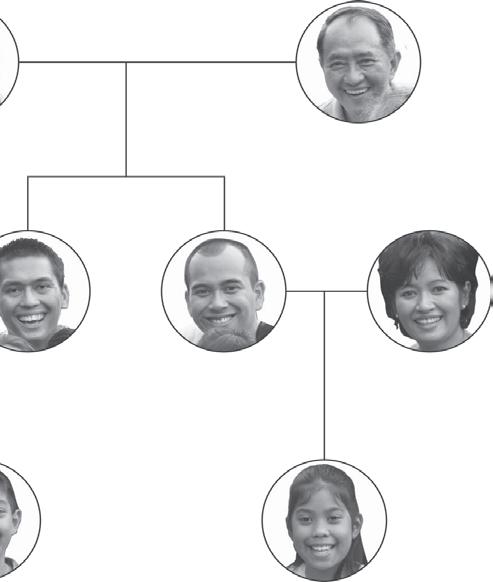
13 minute read
How to use this Teacher’s Resource
This Teacher’s Resource contains both general guidance and teaching notes that help you to deliver the content in our Cambridge Global English resources. Some of the material is provided as downloadable files, available on Cambridge GO. (For more information about how to access and use your digital resource, please see inside front cover.) See the Contents page for details of all the material available to you, both in this book and through Cambridge GO.
Teaching notes
This book provides teaching notes for each unit of the Learner’s Book and Workbook. Each set of teaching notes contains the following features to help you deliver the unit.
The Unit plan summarises the lessons covered in the unit, including the number of learning hours recommended for the lesson, an outline of the learning content and the Cambridge resources that can be used to deliver the lesson.
Lesson Approximate number of learning hours 1 Why are 1–1.5 all families special? Outline of learning content
Talk about why families are special Learning objectives
4Ld.02 4Ld.04 Resources
Learner’s Book Lesson 1.1 Workbook Lesson 1.1 Digital Classroom: Family activities Family vocabulary fun
The Background knowledge feature provides information which helps the teacher to familiarise themselves with the cross-curricular and international content in the unit. Learners’ prior knowledge can be informally assessed through the Getting started feature in the Learner’s Book. BACKGROUND KNOWLEDGE
It is useful to have a good understanding of a range different literary genres (historical fiction, traditional folk and fairy tales and myths, science fiction, mystery stories, fantasy fiction, adventure stories, etc.).
The Teaching skills focus feature covers a teaching skill and suggests how to implement it in the unit. TEACHING SKILLS FOCUS
The challenge with active learning is to stop yourself telling learners things that they could discover for themselves.
Reflecting the Learner’s Book, each unit consists of multiple lessons. At the start of each lesson, the Learning plan table includes the learning objectives, learning intentions and success criteria that are covered in the lesson. It can be helpful to share learning intentions and success criteria with your learners at the start of a lesson so that they can begin to take responsibility for their own learning
LEARNING PLAN
Learning objective Learning intentions 4Rm.01
4Us.06 Reading: Understand the main points of a short text about a sports star’s life. Use of English: Use verbs + infinitive and verbs followed by gerunds to talk about ourselves and our families. Success criteria
Learners can understand, with support, some of the main points of a short text about a sports star’s life.
There are often common misconceptions associated with particular grammar points. These are listed, along with suggestions for identifying evidence of the misconceptions in your class and suggestions for how to overcome them. At Cambridge University Press, we have unique access to the Cambridge Learner Corpus to help us identify common errors for key language groups.
Misconception Learners often, incorrectly, leave out to with hope and want. Learners often use to and -ing in the same sentence. How to identify Elicit correct examples of sentences with hope and want + infinitive; love and enjoy + verb + ing, e.g. I hope to be a doctor. I want to have rice for lunch. How to overcome Practise, for example, using Photocopiable 1: While using the activity, circulate and correct learners when they make these errors.
For each lesson, there is a selection of starter ideas, main teaching ideas and plenary ideas. You can pick out individual ideas and mix and match them depending on the needs of your class. The activities include suggestions for how they can be differentiated or used for assessment. Homework ideas are also provided. communities.
Starter ideas
Thirty-second families game (5 minutes) • Start by revising words for family members.
Nominate learners and give them 30 seconds to talk about their family. Write words that learners find difficult on the whiteboard. • Allow learners 30 seconds to tell a partner about their families. Getting started (10 minutes) • Focus on the big question What is a community?
Elicit names of different types of communities.
Social responsibilities: Tell learners to identify a I belong to’ on the board and build up a list of
variety of groups they belong to. Write ‘Communities • Match the words to a picture. If necessary, show a simple video to reinforce these ideas, like the one in Materials. Then complete the sentences as a class. • Familiarise learners with words for communities by asking them to put communities in size order. Give each group of 3–4 nine small paper squares with the following communities to sort my family, my block/street, my neighborhood, my sports team, my band, my school, my village/city, my country/state, my continent.
The Language background feature contains information to help you present the grammar in the unit. CROSS-CURRICULAR LINKS
The Cross-curricular links feature provides suggestions LANGUAGE BACKGROUND
Use of infinitive and ing after like, love, enjoy, hope, want and learn The use of the infinitive and -ing form after verbs is the focus of the Language detective in this lesson.
In the text, the writer uses the six verbs to talk about what Ezra likes, enjoys, loves doing and activities he hopes, wants and learns to do.
for linking to other subject areas.
PE: After reading about Ezra, brainstorm vocabulary and have a discussion about the movements and training learners do for competitive sports.
Differentiation ideas: This feature provides suggestions for how activities can be differentiated to suit the needs of your class.
Critical thinking opportunities: This feature provides suggestions for embedding critical thinking and other 21st century skills into your teaching and learning.
Assessment idea: This feature highlights opportunities for formative assessment during your teaching.
Digital Classroom: If you have access to Digital Classroom, these links will suggest when to use the various multimedia enhancements and interactive activities.
Answers: Answers to Learner's Book exercises can be found integrated within the lesson plans and Learner's Book and Workbook answer keys are also available to download.
Digital resources to download
This Teacher’s Resource includes a range of digital materials that you can download from Cambridge GO. (For more information about how to access and use your digital resource, please see inside front cover.) This icon indicates material that is available from Cambridge GO. Helpful documents for planning include: • Letter for parents: a template letter for parents, introducing the Cambridge Global English resources. • Lesson plan template: a Word document that you can use for planning your lessons. Examples of completed lesson plans are also provided. • Curriculum framework correlation: a table showing how the Cambridge Global English resources map to the Cambridge English as a Second Language curriculum framework. • Scheme of work: a suggested scheme of work that you can use to plan teaching throughout the year. Each unit includes: • Differentiated worksheets: these worksheets are provided in variations that cater for different abilities. Worksheets labelled ‘A’ are intended to support less confident learners, while worksheets labelled ‘B’ are designed to challenge more confident learners. Answer sheets are provided. • Photocopiable resources: these can include communicative language game, templates and any other materials that support the learning objectives of the unit. • Sample answers: these sample writing answers contain teacher comments, which allow learners and teachers to assess what ‘good’ looks like in order to inform their writing. • End-of-unit tests: these provide quick checks of the learner’s understanding of the concepts covered in the unit. Answers are provided. Advice on using these tests formatively is given in the
Assessment for Learning section of this Teacher’s Resource. • Self-evaluation checklists: checklists for learners to use to evaluate their writing and project work. Additionally, the Teacher’s Resource includes: • Progress test 1: a test to use at the beginning of the year to discover the level that learners are working at. The results of this test can inform your planning. • Progress test 2: a test to use after learners have studied Units 1-5 in the Learner’s Book. You can use this test to check whether there are areas that you need to go over again. • Progress test 3: a test to use after learners have studied all units in the Learner’s Book. You can use this test to check whether there are areas that you need to go over again, and to help inform your planning for the next year. • Progress report: a document to help you formatively assess your classes’ progress against the learning objectives. • End-of-year test and answers: a test to use after learners have studied all units in the Learner’s
Book. You can use this test to check whether there are areas that you need to go over again, and to help inform your planning for the next year. • Audioscripts: available as downloadable files. • Answers to Learner’s Book questions
• Answers to Workbook questions
• Wordlists: an editable list of key vocabulary for each unit. In addition, you can find more detailed information about teaching approaches. Audio is available for download from Cambridge GO (as part of this Teacher’s Resource and as part of the digital resources for the Learner’s Book and Workbook). Video is available through the Digital Classroom.
GLOBAL ENGLISH STAGE 4: UNIT 1 TEST
Name ___________________________________ Date _____________



GLOBAL ENGLISH STAGE4:PROGRESS TEST 1 cousin mum grandpa uncle sister grandma Name ___________________________________ DateProgress Test 1(This test can be photocopied in black and white or colour.) Vocabulary 1Questions 1–5 Complete with the words in the box. Myfamily (0)My grandma (1)My ____________ (2)My _________ My dad (3)My ________ My aunt(4)My _________ Me GLOBAL ENGLISH STAGE 4: UNIT 1 PHOTOCOPIABLES Photocopiable 1: Sports snakes and ladders game Do youlike/enjoy/hope/want/learn/prefer?(-ing vs infinitive) Aim:Learners play a Snakes and ladders style game in groups of four. They ask group members questions using the prompts on the square on which they land. Preparation time: 15 minutes Use of language: Asking and answering present simple questions: Do you like/love/enjoy/prefer + verb+ing? Do you hope/want/learn +infinitive? Vocabulary:play/do/go, sports from Lesson 2 (long jump, football, skateboarding, rugby, basketball, karate, running, swimmingand tennis) Materials: For each group of learners, one Sports snakes and ladders board, one coin with a head/ tails side and one small object (e.g. a pencil sharpener) to represent each learner on the board. Procedure: Learners can dothis gameduring Lesson 2(at the end of Activity 5). Build up a list of sports words learners will need for the game and write under the heading play, do, go. Build up a list of questions learners will need for the game and short answers, e.g. Do you…? 1 Do you like…? 2 Do you hope…? 3 Yes, I do. 4 Do you enjoy…? 5 Do you learn…? 6 No, I don’t. 7 Do you prefer…? …playing football? 8 Do you want…? …to play football? 9 It’s OK. Distribute one Sports snakes and ladders board,and one coin with a head/tails side to each group. Make sure each learner has a small object (e.g. a pencil sharpener) to mark their place on the board. Make sure learners understand that if they land on the head of a snake, they go down tothe bottom and if they land on the foot of the ladder, they go up to the top of it. Choose a group and demonstrate the game. Player 1 tosses the coin. If it lands on the ‘heads’ side, move forward one space. If it lands on tails, move forwards four spaces. The player uses the prompt on the board to make a question, e.g. Square 1: Do you enjoy swimming? Check learners understand which questions to ask. Point to random squares and ask for the question and short answer. Allow time to play the game while you circulate, giving assistance and noting common errors with form and pronunciation. The game ends when one player reaches the finish. Give class feedback on common errors. ___________________________ words in the box. grandma Global English – Helen Tiliouine © Cambridge University Press 2021 1 Unit 1 Test (This test can be photocopied in black and white or colour.) Vocabulary 1 Questions 1–5 Complete the words. Example: 0 f o o t b a l l 1 r __ __ __ __ __ __ [1] 2 l __ __ __ j __ __ __ [1] 3 k __________ [1] 4 b ________________ __ [1] 5 s ________________________ [1] <AW GE4.T1.1 d> <AW GE4.T1.1 e> Do you hope/want/learn +infinitivesports from Lesson 2 ( y, basketball, karate, running,one small object (e.g. a pencil sharpener) to represent each learner on the board. during Lesson 2 Build up a list of sports words learners will need for the game and write under the Build up a list of questions learners will need for the game and short answers, e.g. Sports snakes and ladders board, Make sure each learner has a small object (e.g. a pencil sharpener) to mark their place on the board. understand that if they land on the head of a snake, they go down the bottom and if they land on the foot of the ladder, they go up to the top of it. Choose a group and demonstrate the game. Player 1 tosses the coin. If it lands on the e forward one space. If it lands on tails, move forwards four spaces. The player uses the prompt on the board to make a question, e.g. Square 1: Check learners understand which questions to ask. Point to random squares and ask for the question and short answer. Allow time to play the game while you circulate, giving assistance and noting common errors with form and pronunciation. The game ends when one player reaches the finish. Give class feedback on common errors. GLOBAL ENGLISH STAGE 4: UNIT 1 TEST Grammar 1 Questions 11–15 Write the correct form of the verb (-ing or to + infinitive) in each space. Example: 0 Alan loves fishing in the lake. (fish) 11 Do you enjoy ________________ in the sea? (swim) [1] 12 Do you want ________________ my painting? (see) [1] 13 I’d like to learn ________________ a plane! (fly) [1] 14 My parents enjoy ________________ in the park. (walk) [1] 15 My cousin hopes ________________ lots of mountains. (climb) [1] ________ ________________ my painting? (see) [1] ________________ a plane! (fly) ________________ in the park. (walk) GLOBAL ENGLISH STAGE 4:PROGRESS TEST 1 Reading 1 Questions 21–25 Read the information about the Atacama Desert. Are the sentences true () or false ()? Write or on the lines. _____________



Global English – Nicola Mabbott © Cambridge University Press 2021 1 Global English–Helen Tiliouine© Cambridge University Press 2021 (5)My __________ __________

[Total: 5 marks]
Global English – Helen Tiliouine © Cambridge University Press 2021 Helen Tiliouine © Cambridge University Press 2021 3
The Atacama Desert The Atacama Desert is in Chile, in South America. It is 130 000 km2 and it is older than all the other deserts on Earth. In the Sahara Desert, the temperature is sometimes 50 °C, but in the Atacama Desert it is usually only 18 °C. It hardly ever rains there and it is drier than the Sahara Desert. Scientists go to the Atacama Desert to look at the stars and planets through telescopes because there are about 330 nights every year without any clouds. The Atacama Desert does not support much life, but some very, very tiny animals called microbes can live there. Scientists think that the planet Mars could also support the same kind of life!


Global English – Helen Tiliouine© Cambridge University Press 2021

5 1


